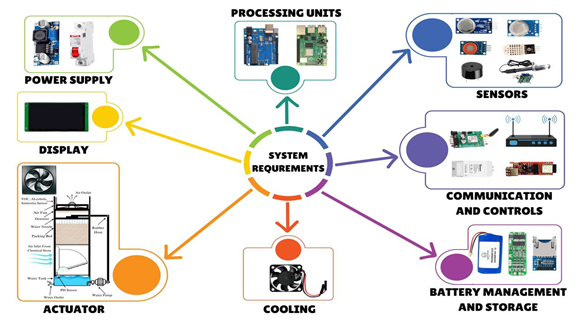Smart Chemical Material Store System Using IOT and Raspberry PI
DOI:
https://doi.org/10.58564/IJSER.3.2.2024.175Keywords:
Chemical Materials, Sensors, K-Means Algorithm, Smart Storage System, Raspberry PI4BAbstract
Within the period of savvy innovation, the administration of chemical capacity postures critical challenges, especially in guaranteeing security and natural compliance. This paper plan and usage of a keen chemical capacity framework utilizing Raspberry PI presents an imaginative arrangement to this squeezing issue by leveraging the capabilities of Raspberry PI4 and the Web of Things (WoT) innovation. This investigate expresses the advancement and sending of a exceedingly productive, cost-effective shrewd chemical capacity framework outlined to optimize security, energy saving and protecting the internal and external environment of the store from air pollution. By coordination sensors for identifying different chemical gasses, temperature, mugginess, and pH levels, washing column, the framework gives real-time information examination, guaranteeing a responsive and energetic approach to chemical capacity administration. The Raspberry PI4 serves as the central handling unit, coordinating information procurement, processing, and decision-making forms to preserve ideal capacity conditions and preemptively address potential risks. Through the utilization of K-Means Calculation for information investigation, the framework illustrates extraordinary capability in recognizing and cautioning to dangerous conditions, in this way essentially decreasing the hazard of chemical mischances and processed. The usage exhibits a versatile, versatile system that obliges the expansion of different sensors and gadgets, encouraging a comprehensive observing arrangement custom-made to the particular needs of chemical capacity offices. This investigate not only contributes to the field of chemical security but moreover sets a point of reference for the application of savvy advances in mechanical security administration, advertising experiences and techniques that can be adjusted over assorted segments.
References
M. M. Alam, R. Bin Mofidul, and Y. M. Jang, “Community energy storage system: Deep learning based optimal energy management solution for residential community,” J. Energy Storage, vol. 64, no. February, p. 107100, 2023, doi: 10.1016/j.est.2023.107100. DOI: https://doi.org/10.1016/j.est.2023.107100
J. De Paepe, L. De Pryck, A. R. D. Verliefde, K. Rabaey, and P. Clauwaert, “Electrochemically Induced Precipitation Enables Fresh Urine Stabilization and Facilitates Source Separation,” Environ. Sci. Technol., vol. 54, no. 6, pp. 3618–3627, 2020, doi: 10.1021/acs.est.9b06804. DOI: https://doi.org/10.1021/acs.est.9b06804
T. Hussain et al., “Internet of Things with Deep Learning-Based Face Recognition Approach for Authentication in Control Medical Systems,” Comput. Math. Methods Med., vol. 2022, pp. 1–17, Feb. 2022, doi: 10.1155/2022/5137513. DOI: https://doi.org/10.1155/2022/5137513
R. M. Nienhuis, M. van Rooij, W. A. Prins, B. Jayawardhana, and A. I. Vakis, “Investigating the efficiency of a novel offshore pumped hydro energy storage system: Experimental study on a scale prototype,” J. Energy Storage, vol. 74, no. April, 2023, doi: 10.1016/j.est.2023.109374. DOI: https://doi.org/10.1016/j.est.2023.109374
M. A. Hailan, B. M. Albaker, and M. S. Alwan, “Two-Dimensional Transformation of a Conventional Manufacturer into a Smart Manufacturer: Architectonic Design, Maintenance Strategies and Applications,” Al-Iraqia J. Sci. Eng. Res., vol. 1, no. 1, pp. 77–87, 2022, doi: 10.33193/ijser.1.1.2022.39. DOI: https://doi.org/10.33193/IJSER.1.1.2022.39
R. MacÍas-Quijas, R. Velázquez, R. De Fazio, P. Visconti, N. I. Giannoccaro, and A. Lay-Ekuakille, “Reliable e-nose for air toxicity monitoring by filter diagonalization method,” Int. J. Electr. Comput. Eng., vol. 12, no. 2, pp. 1286–1298, 2022, doi: 10.11591/ijece.v12i2.pp1286-1298.
F. Palacio, J. Fonollosa, J. Burgues, J. M. Gomez, and S. Marco, “Pulsed-temperature metal oxide gas sensors for microwatt power consumption,” IEEE Access, vol. 8, pp. 70938–70946, 2020, doi: 10.1109/ACCESS.2020.2987066. DOI: https://doi.org/10.1109/ACCESS.2020.2987066
R. Kiruthika and A. Umamakeswari, “Low cost pollution control and air quality monitoring system using Raspberry Pi for Internet of Things,” 2017 Int. Conf. Energy, Commun. Data Anal. Soft Comput. ICECDS 2017, pp. 2319–2326, 2018, doi: 10.1109/ICECDS.2017.8389867. DOI: https://doi.org/10.1109/ICECDS.2017.8389867
H. K. Ren, M. Ashtine, M. McCulloch, and D. Wallom, “An analytical method for sizing energy storage in microgrid systems to maximize renewable consumption and minimize unused storage capacity,” J. Energy Storage, vol. 68, no. January, 2023, doi: 10.1016/j.est.2023.107735. DOI: https://doi.org/10.1016/j.est.2023.107735
J. D. Prades et al., “Quantitative analysis of CO-humidity gas mixtures with self-heated nanowires operated in pulsed mode,” Appl. Phys. Lett., vol. 97, no. 24, pp. 1–3, 2010, doi: 10.1063/1.3515918. DOI: https://doi.org/10.1063/1.3515918
L. Cheng, Q. H. Meng, A. J. Lilienthal, and P. F. Qi, “Development of compact electronic noses: A review,” Meas. Sci. Technol., vol. 32, no. 6, 2021, doi: 10.1088/1361-6501/abef3b. DOI: https://doi.org/10.1088/1361-6501/abef3b
R. Zukerman et al., “Modeling and simulation of a smart catalytic converter combining NOx storage, ammonia production and SCR,” Chem. Eng. J., vol. 155, no. 1–2, pp. 419–426, 2009, doi: 10.1016/j.cej.2009.08.015. DOI: https://doi.org/10.1016/j.cej.2009.08.015
S. J. Sanjay Kumar Jain, Jyoti Singhai, “Techniques for human odor analysis: Areview,” Int. J. Latest Trends Eng. Technol., vol. 2, no. 1, pp. 174–185, 2013.
Ms. Kshitija Tanaji Kamble, Ms. Arpita Vijaykumar Khatake, Ms. Aishwarya Chandrakant Ghadyalji, and Prof. A. B. Chounde, “IOT Based Air Pollution Monitoring System using Raspberry Pi,” Int. J. Adv. Res. Sci. Commun. Technol., pp. 332–336, Jun. 2022, doi: 10.48175/IJARSCT-5032. DOI: https://doi.org/10.48175/IJARSCT-5032
G. Marques and R. Pitarma, “An indoor monitoring system for ambient assisted living based on internet of things architecture,” Int. J. Environ. Res. Public Health, vol. 13, no. 11, 2016, doi: 10.3390/ijerph13111152. DOI: https://doi.org/10.3390/ijerph13111152
E. S. Reddy, M. M. Kumar, V. Sajjan, and G. Nagesh, “IOT Based Indoor And Outdoor Air Pollution Monitoring System Using Raspberry PI,” J. Pharm. Negat. Results, vol. 13, no. 7, pp. 4633–4643, 2022, doi: 10.47750/pnr.2022.13.S07.577.
M. Ibrahim, A. Elgamri, S. Babiker, and A. Mohamed, “Internet of things based smart environmental monitoring using the Raspberry-Pi computer,” in 2015 Fifth International Conference on Digital Information Processing and Communications (ICDIPC), IEEE, Oct. 2015, pp. 159–164. doi: 10.1109/ICDIPC.2015.7323023. DOI: https://doi.org/10.1109/ICDIPC.2015.7323023
O. Taiwo, A. E. Ezugwu, O. N. Oyelade, and M. S. Almutairi, “Enhanced Intelligent Smart Home Control and Security System Based on Deep Learning Model,” Wirel. Commun. Mob. Comput., vol. 2022, 2022, doi: 10.1155/2022/9307961. DOI: https://doi.org/10.1155/2022/9307961
A. N. Abdullah, K. Kamarudin, S. M. Mamduh, and A. H. Adom, “Development of MOX Gas Sensors Module for Indoor Air Contaminant Measurement,” IOP Conf. Ser. Mater. Sci. Eng., vol. 705, no. 1, 2019, doi: 10.1088/1757-899X/705/1/012029. DOI: https://doi.org/10.1088/1757-899X/705/1/012029
M. K. Ibrahim, N. M. Hussien, and S. N. Alsaad, “Smart system for monitoring ammonium nitrate storage warehouse,” Indones. J. Electr. Eng. Comput. Sci., vol. 23, no. 1, pp. 583–589, 2021, doi: 10.11591/ijeecs.v23.i1.pp583-589. DOI: https://doi.org/10.11591/ijeecs.v23.i1.pp583-589
R. Macías-Quijas, R. Velázquez, R. De Fazio, P. Visconti, N. I. Giannoccaro, and A. Lay-Ekuakille, “Reliable e-nose for air toxicity monitoring by filter diagonalization method,” Int. J. Electr. Comput. Eng., vol. 12, no. 2, p. 1286, Apr. 2022, doi: 10.11591/ijece.v12i2.pp1286-1298. DOI: https://doi.org/10.11591/ijece.v12i2.pp1286-1298
M. F. R. Al-Okby, T. Roddelkopf, H. Fleischer, and K. Thurow, “Evaluating a Novel Gas Sensor for Ambient Monitoring in Automated Life Science Laboratories,” Sensors, vol. 22, no. 21, p. 8161, Oct. 2022, doi: 10.3390/s22218161. DOI: https://doi.org/10.3390/s22218161
J. N. Shrote, “BioGecko SMART AIR POLLUTION MONITORING SYSTEM USING IOT AND BioGecko,” vol. 12, no. 02, pp. 1746–1753, 2023.
S. H. Alnajjar and H. M. Mahmoud, “Internet of Things-Based Air Pollution Monitoring System for the Indoor Environment Utilizing Light Fidelity Technology,” in 2023 9th International Conference on Optimization and Applications (ICOA), IEEE, Oct. 2023, pp. 1–5. doi: 10.1109/ICOA58279.2023.10308844. DOI: https://doi.org/10.1109/ICOA58279.2023.10308844
R. Sarif, M. F. R. Al-Okby, T. Roddelkopf, and K. Thurow, “MOBILE GAS SENSING FOR LABORATORY INFRASTRUCTURE,” IIUM Eng. J., vol. 25, no. 1, pp. 178–207, Jan. 2024, doi: 10.31436/iiumej.v25i1.2727. DOI: https://doi.org/10.31436/iiumej.v25i1.2727
M. A. Fayad, A. D. J. Al-Bayati, H. A. Abdul Wahhab, A. J. Sultan, L. S. Sabri, and H. A. Dhahad, “Effect of FIPs strategy and nanoparticles additives into the renewable fuel blends on NOX emissions, PM size distribution and soot oxidation in CRDI diesel engine,” Results Eng., vol. 21, p. 101748, Mar. 2024, doi: 10.1016/j.rineng.2024.101748. DOI: https://doi.org/10.1016/j.rineng.2024.101748

Downloads
Published
How to Cite
Issue
Section
License
Copyright (c) 2024 Samah Faris Kamil, M. N. Al-Turfi, Riyadh S. Almukhtar

This work is licensed under a Creative Commons Attribution-ShareAlike 4.0 International License.
Deprecated: json_decode(): Passing null to parameter #1 ($json) of type string is deprecated in /var/www/vhosts/ijser.aliraqia.edu.iq/httpdocs/plugins/generic/citations/CitationsPlugin.inc.php on line 49









